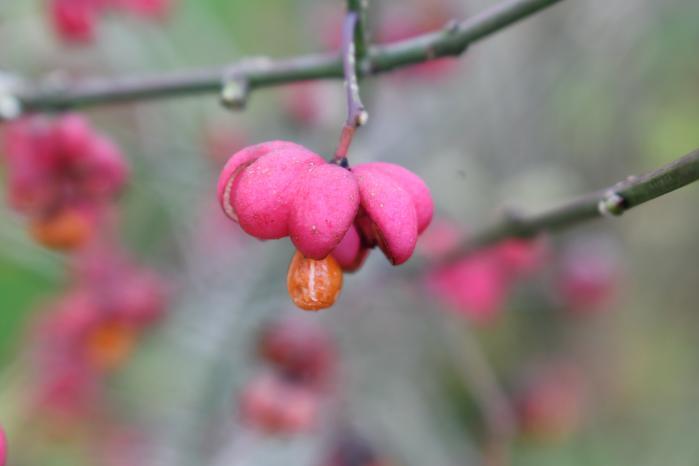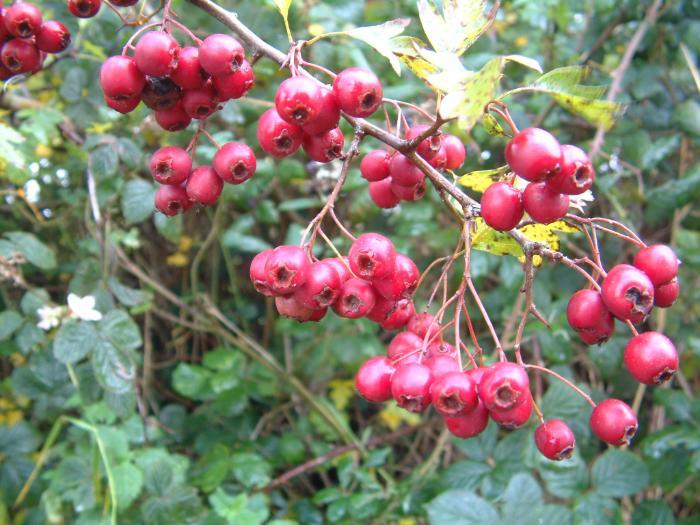19 November 2023
Growing Wild – Haws and Spindle fruit

Now is the time to look out for haws and spindle fruit. Catherine Keena, Teagasc Countryside Management Specialist, who takes a closer look at some of our native Irish biodiversity.
Haws

Look out for haws, the red berries of the whitethorn loved by birds, such as fieldfare, thrush and migrating redwing, as well as small mammals. In folklore, whitethorn was associated with magic and to interfere with lone fairy thorn trees or trees growing on ringforts or other archaeological features was very unlucky. Boughs laden with haws are found on whitethorn allowed grow up into mature trees, whether in lines of whitethorn trees in treeline hedges or on occasional individual whitethorn trees growing in topped hedges. Having treeline or escaped hedges with mature whitethorn trees and retaining individual thorn trees within topped hedges are both essential for our native Irish biodiversity.
Spindle fruit

Look out for spindle fruit with the conspicuous colour combination of shocking pink four-lobed fruit, now mostly open revealing bright orange seeds, among vivid crimson and yellow leaves. The fruits are eaten by birds including thrushes, finches and tits while the green four sided stems provide host sites for the eggs of black bean aphids to overwinter until hatching next spring. Larvae of butterflies and moths use spindle leaves including holly blue butterfly and spindle ermine moth. It hosts a gall produced by a gall mite and a multi-layered brown bracket formed by a bracket fungus. Spindle also known as pegwood is part of our native Irish biodiversity.
See previous Growing Wild articles below:
- Growing Wild – Crab Apples and Elderberries
- Growing Wild – Ivy flowers and Common knapweed
- Growing Wild – Meadowsweet, Ox-eye Daisy and Selfheal
- Growing Wild – Marsh marigold and Ribwort plantain
- Growing Wild – Dandelions and cowslips
- Growing Wild – Lesser Celandine and Ivy berries
- Growing Wild – Winter Heliotrope and frogspawn
- Growing Wild – Willow Catkins and Birds Nests
- Growing Wild – Harts Tongue and Hazel
- Growing Wild – Whins and Ferns
- Growing Wild – Rose Hips and Flowering Ivy
- Growing Wild – Yarrow and Herb Robert
- Growing Wild – Elderberries and Blackberries
- Growing Wild – Haws and Spindle
- Growing wild – Guelder Rose and Sloes
- Growing wild – Purple loosestrife and Lord and Ladies
- Growing Wild – willowherb and water mint
- Growing Wild – dandelion and greater stitchwort
- Growing Wild – willow, primrose and lady’s smock
- Growing Wild – whitethorn and cow parsley
- Growing Wild – bluebells and guelder rose
- Growing wild – Honeysuckle and Foxglove
- Growing Wild – Elder and Ragged Robin
- Growing wild – dog rose and meadowsweet
- Growing wild – Privet and Lady’s Bedstraw
- Growing Wild – Bird’s foot trefoil and Knapweed
Keep an eye on Teagasc Daily for Growing Wild updates.
Learn more from Teagasc about Biodiversity and Countryside here.
